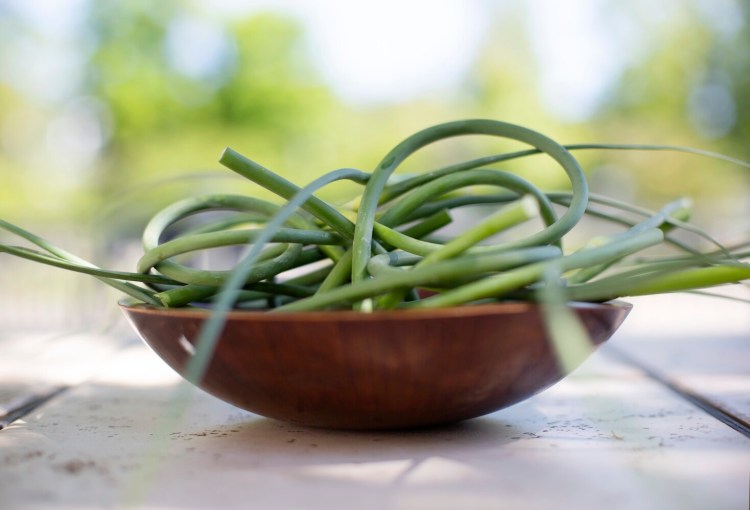I am always intrigued by the prospect of an affordable early summer bundle of garlic scapes. I admire how they curl around themselves like a cloverleaf highway intersection. I love how they add a pleasant garlicky crunch when they are very thinly sliced and sprinkled over almost anything savory from bruschetta and crostini to pasta and pizza. And they soothe my sustainability sensibilities because they give farmers a couple extra bucks (my informal survey of this year’s prices shows they cost $1.50-$2 per bunch) for what it essentially a byproduct of the local hardneck garlic crop.
But I must confess that I rarely get through a whole 10-scape bundle with creative aplomb. The last two or three scapes languishing in the crisper routinely get pulverized into pesto. I am perfectly pleased to find a tub of garlic scape pesto in the back of the fridge in late January. But I’ve also been on the prowl for a predictably easy way to prep all the scapes in a bundle on the day I buy them and a quick preservation technique that will let me use them with ease and abandon until the next market day. As a bonus, this technique would keep me stocked with a utilitarian garlic condiment until newly dried local garlic bulbs are available in the fall.
Scapes differ from green garlic. The latter are young garlic plants that are pulled from the ground in spring before bulbs are even formed so that the remaining plants have room to grow. Green garlic resembles scallions.
Scapes are strictly an early summer thing. They shoot out of the ground from promising garlic bulbs. The curly green stalks have tightly closed buds punctuated by long, elegant points. Farmers harvest them right about now so they don’t drain nutrients from the maturing garlic bulbs.
The flavor of any garlic products will vary, but I substitute them for each other frequently. Since garlic at any stage gets more pungent as it matures from green garlic to scapes to heads and cloves, I’ve developed a conversion: 2 tablespoon minced green garlic = 1 tablespoon minced garlic scapes = 1 ½ teaspoons minced garlic cloves.
But let’s get back to my scape preservation investigation. I like scapes raw and sliced very thinly (about 1/16th of an inch) because the outer skin can be very fibrous. I wanted to preserve them in these thin slices.
I tried simply slicing a large bunch and storing them in in the fridge. The ones on top dried out while the ones on the bottom got slimy before I could use them all. I tried holding others in water, but as they floated, the water leached their flavor and pulled the thin outer coating from the slices making the lot of them a tangled mess. I tried preserving them with salt, a technique I use with herbs, but they gave off little liquid, so that experiment was a flop.

Scapes in oil offer handy, tasty way to preserve garlic scapes, which are in season now. Derek Davis/Staff Photographer Buy this Photo
What about using oil to preserve them? I plopped them in a mixture of half olive oil and half vegetable oil. After a few days, the scapes were fine, but little of their flavor had transferred to the oil.
Before slicing scapes, I trim off the bud end because I can use the section from bud to the pointed tip like chives. This time, I blanched those sections like I would chives and blended them with the oil. To the bright green, flavored oil that resulted, I added the sliced scapes.
I ended up with just what I’d been searching for: a fail-safe way to tame every tangle of garlic scapes that land in my kitchen.
CHRISTINE BURNS RUDALEVIGE is a food writer, recipe developer and tester, and cooking teacher in Brunswick, and the author of “Green Plate Special,” a cookbook from Islandport based on these columns. She can be contacted at cburns1227@gmail.com.

Just looking at this photo is making us hungry. Crostini with garlic scapes in oil. Top: sauteed mushrooms, red onions and scapes in oil. Center: cultured butter, radishes, scapes in oil and sea salt. Bottom: ricotta, spinach, tomato and scapes in oil. Derek Davis/Staff Photographer Buy this Photo
Scapes in Oil
The scapes will keep in the refrigerator for three weeks or in the freezer for three months. The scape-infused oil makes a great base for salad dressing or a quick pasta sauce.
Makes 1 1/2 cups
1 bunch of scapes (8-10)
Salt
1/4 cup olive oil
1/4 vegetable oil
Trim the softer bud ends of the scapes from the tougher curled end of the scapes.
Place a saucepan full of salted water over high heat to boil. When it boils, place the soft scape tops into the water and cook for 1 minute. Drain the scape tops and run cold water over them. Squeeze the water from the scapes, then place them in the blender. Add the oils and 1/2 teaspoon kosher salt. Blend until the oil is bright green, about 30 seconds. Let the scape oil sit while you very thinly slice the remaining scape stalks on a diagonal.
Strain the oil through a fine-mesh sieve into a jar. Add the sliced scapes to the oil. Let sit for 24 hours before using.
Send questions/comments to the editors.



Comments are no longer available on this story